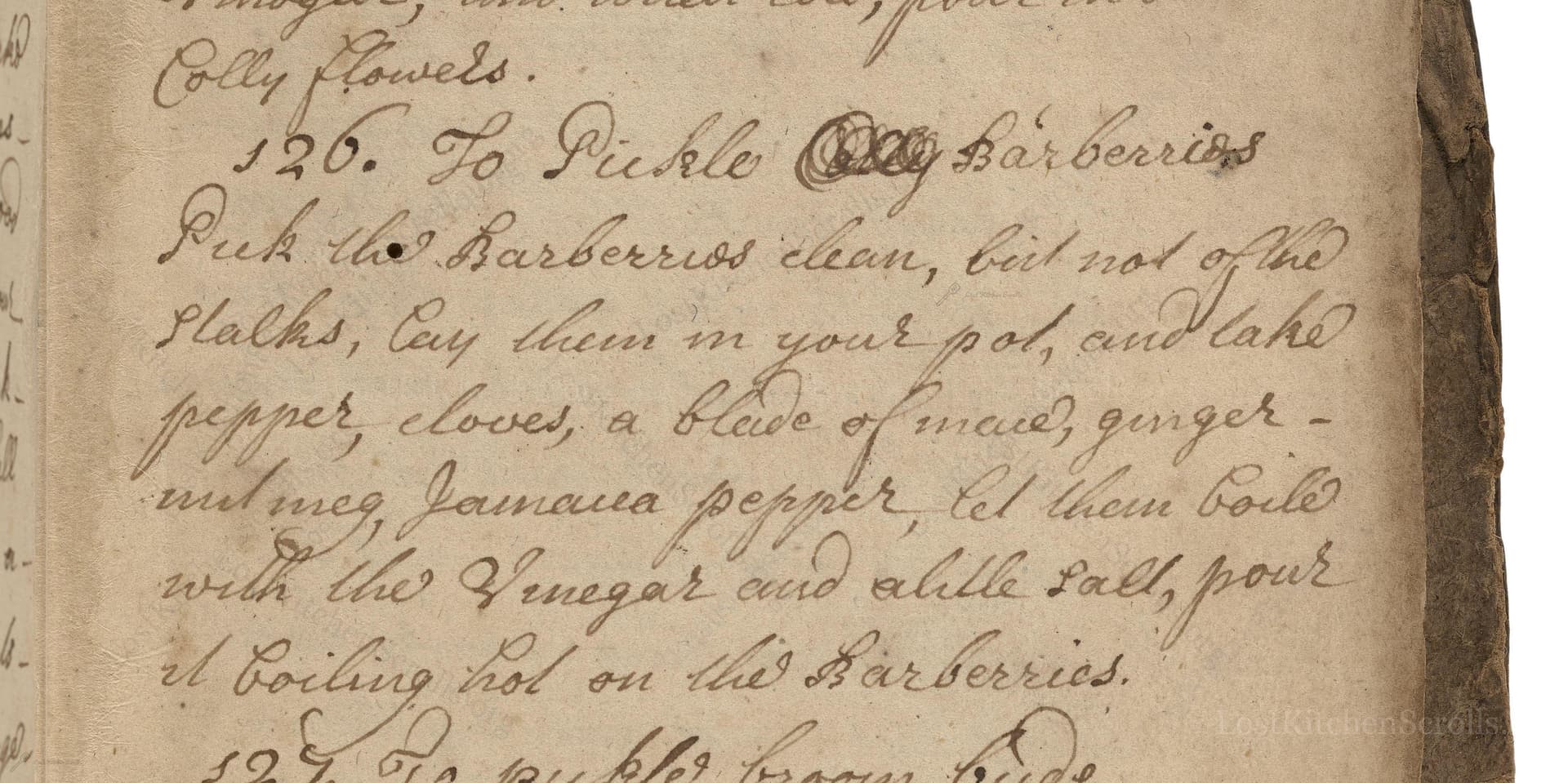To Pickle Barberries
From the treasured pages of Receipts for cookery and pastry work
Written by Mrs. Johnston

To Pickle Barberries
"Pick the Barberries clean, boil not of the Stalks, lay them in your pot, and take pepper, cloves, a blade of mace, ginger - nutmeg, Jamaica pepper, let them boil with the Vinegar and a litle Salt, pour it boiling hot on the Barberries."
Note on the Original Text
The recipe is written in the instructional, almost conversational style typical of early modern English cookbooks: concise, lacking in precise measurements, and expecting the cook to possess some culinary intuition and experience. The phrasing—such as 'boil not of the stalks'—could be confusing to the modern reader but simply instructs to keep the little stalks attached for better results. Spelling and punctuation in such manuscripts were highly variable, and ingredients like 'Jamaica pepper' refer to what we now call allspice. Recipes often mixed old and new world spices, reflecting both changing tastes and the increasing availability of international ingredients.

Title
Receipts for cookery and pastry work (1700)
You can also click the book image above to peruse the original tome
Writer
Mrs. Johnston
Era
1700
Publisher
Unknown
Background
A delightful compilation of 18th-century recipes gathered by Mrs. Johnston herself, promising a charming journey through the flavors and culinary traditions of the early 1700s.
Kindly made available by
Folger Shakespeare Library
This recipe is drawn from the turn of the 18th century, compiled by Mrs. Johnston around 1700, a time when English householders commonly preserved fruits and vegetables for use throughout the winter. Barberries, prized for their bright color and tart flavor, were often pickled in vinegar infused with warming spices. Such recipes reflect the era's enthusiasm for tangy and spiced preserves, ensuring both flavor and safe storage before refrigeration. Pickled barberries like these were used to garnish meat dishes or add acidity to rich sauces and stews—an early example of how sour notes enlivened the period’s cuisine.

In the early 1700s, preserving would take place in the home kitchen, typically using an earthenware or stoneware pot to hold the barberries. The vinegar and spices would be boiled together in a sturdy metal or brass pan over an open hearth. The hot liquid was carefully ladled over the barberries, sometimes using a simple jug or copper ladle, and the preserve sealed with parchment or waxed cloth tied on with string. No modern canning or bottling existed, so ensuring a tight seal and a cool storage space was crucial for extending the shelf life of the pickles.
Prep Time
10 mins
Cook Time
10 mins
Servings
15
We've done our best to adapt this historical recipe for modern kitchens, but some details may still need refinement. We warmly welcome feedback from fellow cooks and culinary historians — your insights support the entire community!
Ingredients
- 1 pound (16 ounces) fresh barberries (substitute: dried barberries soaked in water, if fresh unavailable)
- 2 cups white wine vinegar (or cider vinegar as substitute)
- 1 teaspoon (about 0.2 ounces) sea salt
- 1 teaspoon (about 0.1 ounces) whole black peppercorns
- 1 teaspoon (about 0.1 ounces) whole cloves
- 1 small blade mace or 1/2 teaspoon ground mace
- 1 thumb (3/4 inch) fresh ginger, sliced
- 1/2 teaspoon (about 0.04 ounces) grated nutmeg
- 1 teaspoon (about 0.1 ounces) allspice (Jamaica pepper)
Instructions
- Begin by taking about 1 pound (16 ounces) of fresh barberries.
- Remove any stems, leaves, or debris from the berries, but do not strip them completely of the tiny stalks—they help the berries hold their shape while pickling.
- Place the cleaned barberries into a sterilized glass jar or ceramic pot.
- In a saucepan, combine 2 cups of white wine vinegar, 1 teaspoon (about 0.2 ounces) of sea salt, 1 teaspoon (about 0.1 ounces) of whole black peppercorns, 1 teaspoon (about 0.1 ounces) of whole cloves, 1 small blade of mace or 1/2 teaspoon ground mace, a 3/4-inch thumb of fresh ginger (sliced), 1/2 teaspoon (about 0.04 ounces) of grated nutmeg, and 1 teaspoon (about 0.1 ounces) of allspice (Jamaica pepper).
- Bring this mixture to a boil, stirring to dissolve the salt.
- Once boiling, pour the hot, spiced vinegar mixture directly over the barberries, ensuring they are fully submerged.
- Seal the jar while hot and let it cool.
- Store in the refrigerator or a cool, dark place.
- The pickled barberries will be ready to use after a week and best eaten within a few months.
Estimated Calories
15 per serving
Cooking Estimates
You will need about 10 minutes to prepare the ingredients and jar, plus 10 minutes to cook the spiced vinegar. This recipe makes about one 1-liter jar of pickled barberries, with each serving estimated at around 30 grams. Each serving has just a few calories since the main ingredients are berries and vinegar.
As noted above, we have made our best effort to translate and adapt this historical recipe for modern kitchens, taking into account ingredients nowadays, cooking techniques, measurements, and so on. However, historical recipes often contain assumptions that require interpretation.
We'd love for anyone to help improve these adaptations. Community contributions are highly welcome. If you have suggestions, corrections, or cooking tips based on your experience with this recipe, please share them below.
Join the Discussion
Rate This Recipe
Dietary Preference
Main Ingredients
Culinary Technique

Den Bockfisch In Einer Fleisch Suppen Zu Kochen
This recipe hails from a German manuscript cookbook compiled in 1696, a time whe...

Die Grieß Nudlen Zumachen
This recipe comes from a rather mysterious manuscript cookbook, penned anonymous...

Ein Boudain
This recipe comes from an anonymous German-language manuscript cookbook from 169...

Ein Gesaltzen Citroni
This recipe, dating from 1696, comes from an extensive anonymous German cookbook...
Browse our complete collection of time-honored recipes



